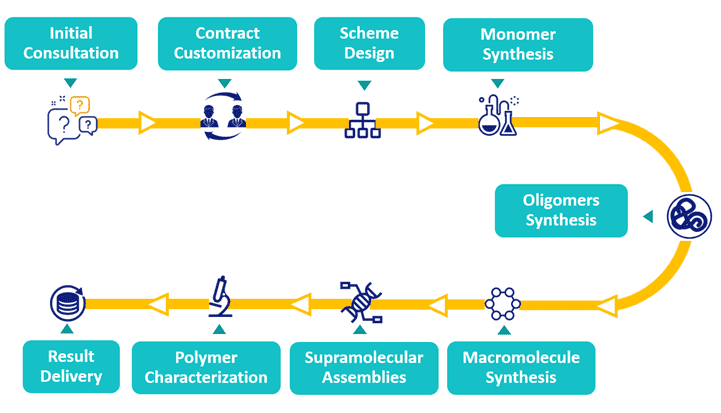
Re-engineering of mammalian cell surfaces with synthetic polymers is emerging as an approach to enable rapid, simple and versatile chemical re-modeling of cells to introduce non-natural functionality. BOC Sciences is committed to developing cutting-edge polymer development technology. We have established advanced polymer bioconjugation platform, including protein-polymer conjugates, peptide-polymer conjugates, nucleic acids-polymer conjugates, carbohydrates-polymer conjugates, enzymes-polymer conjugates, viruses-polymer conjugates, and liposome-polymer conjugates, as well as subsequent formulation development of products.
Introduction of Cells-polymer Conjugates
Cell surface engineering is a methodology in which the cell surface is tailored to modulate cellular function and interactions. The cell surface is a highly heterogeneous environment, displaying distinct types of proteins, glycans and lipids. These structures have a critical role in governing cell fate including regulating cell-cell interaction, cell-niche communication and intracellular signaling pathways. An assortment of reactive functional groups including amines, thiols and carbonyls decorate the cell surface, providing a fertile landscape for exogenous modification. As the cell surface is an integral aspect of cell function, controlling the biochemical and cellular functions of cells by engineering the cell membrane with polymers allow new opportunities in drug delivery, cell-based therapeutics, transfusion, tissue engineering and exploring fundamental cell biology.
 Fig. 1. Examples of cell-polymer conjugates schemes (Nat. Chem. 2017, 9 (6): 537-545).
Fig. 1. Examples of cell-polymer conjugates schemes (Nat. Chem. 2017, 9 (6): 537-545).
Cell-polymer conjugates could provide improved in vivo compatibility as well as reduced immune responses and enzymatic degradation can be afforded to modified cells, suggesting entirely new perspectives for fundamental studies in cell biology as well as applications in transfusion, cell-based therapeutics, and tissue engineering. Compared with natural biopolymers, artificial polymers with biocompatibility and biofunctionality would show effective applications without the concern of protein denaturation and undesired immunological effects. Semi-synthetic biopolymers, which combine natural and synthetic polymers into hybrid polymers by blending, crosslinking, and grafting techniques, have also sparked an interest in materials science. The biocompatibility of natural polymers combined with the great thermal and mechanical properties of synthetic polymers created semi-synthetic polymers with a wide range of applications in biomedicine.
Applications of Cells-polymer Conjugates
Synthetic polymers with various shapes, sizes, and functions have been extensively investigated for biomedical applications due to their versatility in components, properties, and structures. The interaction between synthetic polymers and living cells has been studied over time to increase their cytocompatibility and control physicochemical properties. Up to now, synthetic polymers as biomaterials have been investigated in the fabrication of medical devices, tissue engineering scaffolds and organ substitution, owing to their unique characteristics of high porosity with very tiny pore size, biodegradability, high surface-to-volume ratio, and mechanical property. Some commercial synthetic polymers, including polyesters, polypropylene, silicones, and polyurethanes with inactivity and biocompatibility play important roles in soft tissue replacement.
Our Services of Cells-polymer Conjugates
Covalent Modification of Live Cells
While a variety of functional groups are readily available on the cell surface, only a few functional moieties are reactive in the extremely complex and heterogeneous environment of the cell surface. Lysine (amine, -NH2) and cysteine (thiol, -SH) side chains are the residues most often recruited for direct covalent attachment of polymers to the cell surface. This approach is considered simple and straight forward as cells do not require any chemical or genetic pre-conditioning. The exogenous ligating substrates, however, must be pre-activated before delivery to the cell surface. Armed with rich experience in polymer modification, BOC Sciences has developed highly integrated platforms that can conjugate live cells and polymer with different functional groups. Our covalent modification strategies include:

Grafting from Strategies of Live Cells
Surface initiated polymerizations such as atom transfer radical polymerization (ATRP) and reversible addition fragmentation chain-transfer (RAFT) polymerization have been intensely studied for different applications including the generation of non-biofouling surfaces, cell-selective adhesiveness, and stimuli-response materials. In a similar manner, the grafting of synthetic polymers on cell surface offer unique advantages over proteins, especially in terms of changing the physical properties of modified surface, increasing the functional groups for secondary interactions, and providing opportunities to generate cell-polymer hybrid structures. BOC Sciences is committed to providing flexible live cells-polymer conjugate strategies at competitive prices. In BOC Sciences, we support various cells bioconjugation services (including red blood cells, white blood cells (lymphocytes, macrophages), stem cells (multipotent and pluripotent), islet cells, cancer cells and endothelial cells) for global customers to achieve new drug discovery milestones with comprehensive and advanced platforms.
Our Polymer Bioconjugation Workflow

References
- Weil, T. et al. Polymer bioconjugates: modern design concepts toward precision hybrid materials. Progress in Polymer Science. 2020, 105: 101241.
- Kizhakkedathu, J.N. et al. Surface engineering for cell-based therapies: techniques for manipulating mammalian cell surfaces. ACS Biomater. Sci. Eng. 2018, 4(11): 3658-3677.
- Kizhakkedathu, J.N. et al. Enhanced cell surface polymer grafting in concentrated and nonreactive aqueous polymer solutions. J. AM. CHEM. SOC. 2010, 132: 3423-3430.
- Gibson, M.I. et al. Engineering cell durfaces bycovalent grafting of synthetic polymers to metabolically-labeled glycans. ACS Macro Lett. 2018, 7: 1289-1294.
- Liu, B. et al. Living cell-mediated in-situ polymerization for biomedical applications. Progress in Polymer Science. 2022, 129: 101545.


 Fig. 1. Examples of cell-polymer conjugates schemes (Nat. Chem. 2017, 9 (6): 537-545).
Fig. 1. Examples of cell-polymer conjugates schemes (Nat. Chem. 2017, 9 (6): 537-545).













